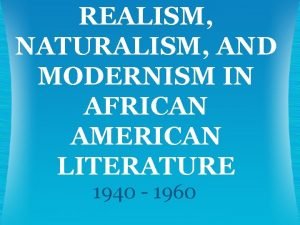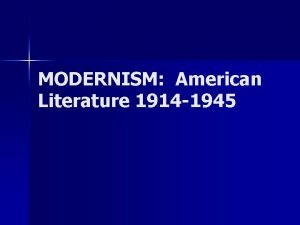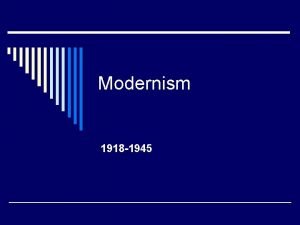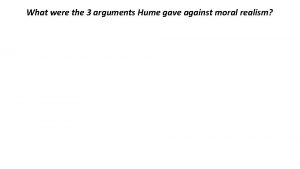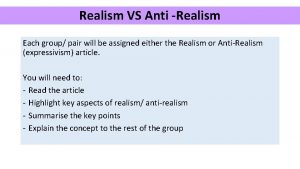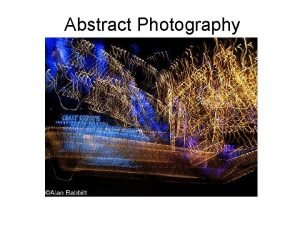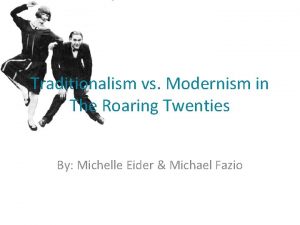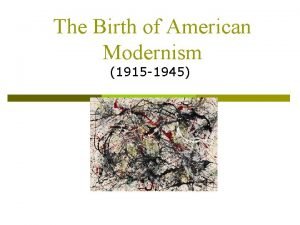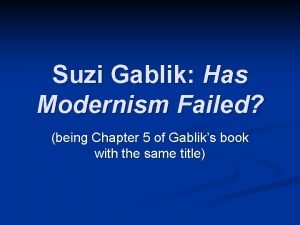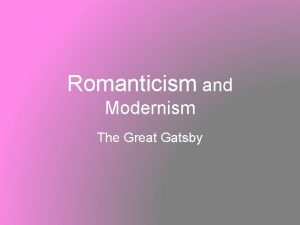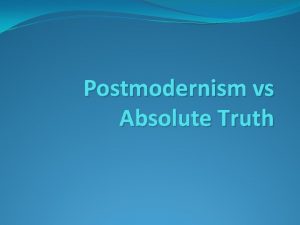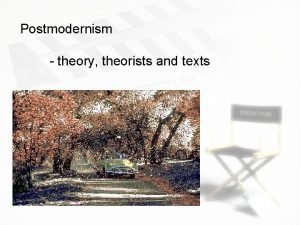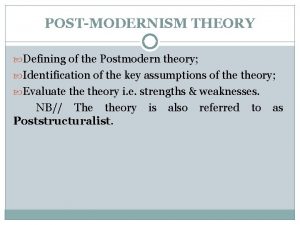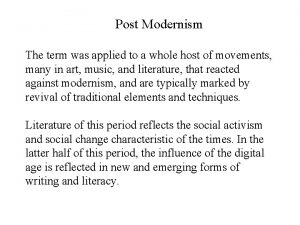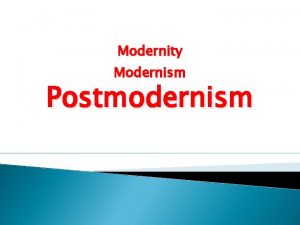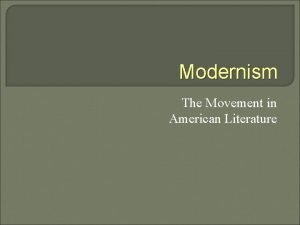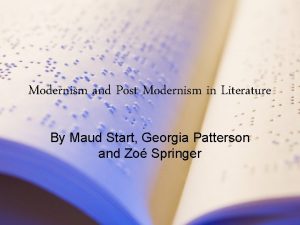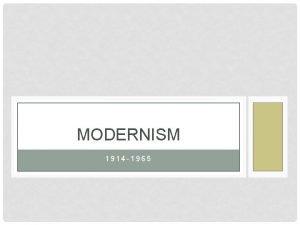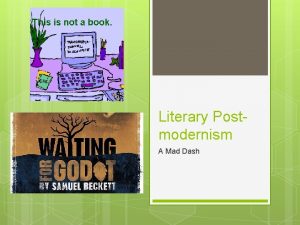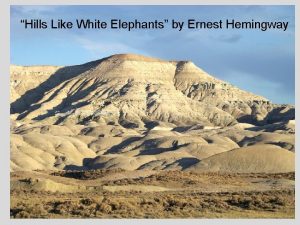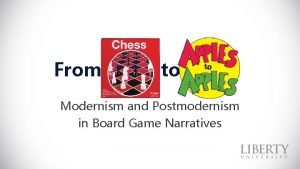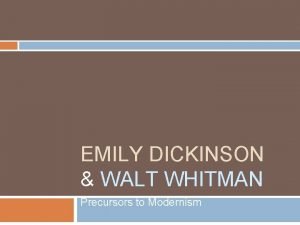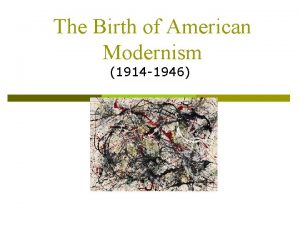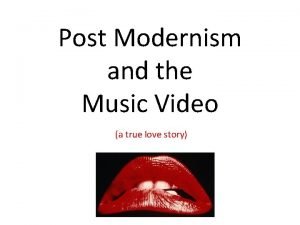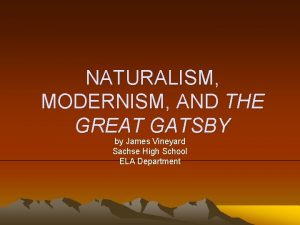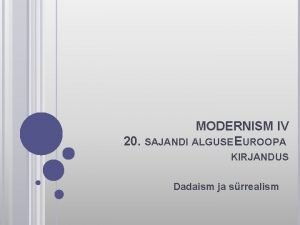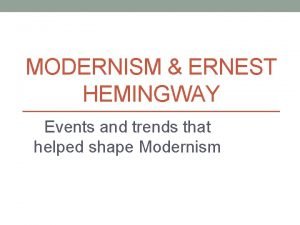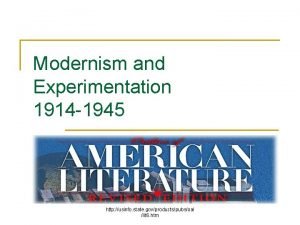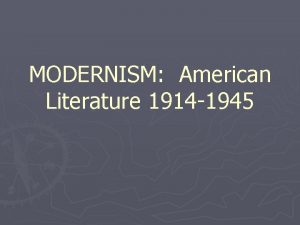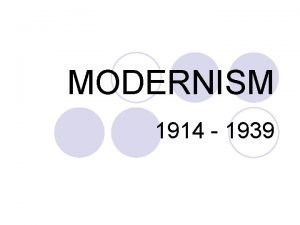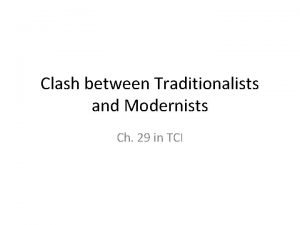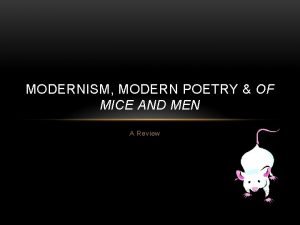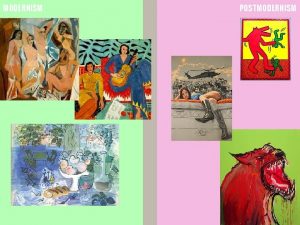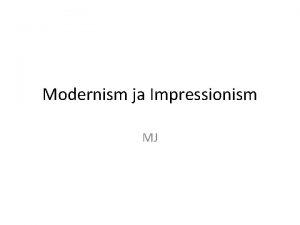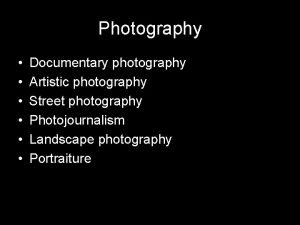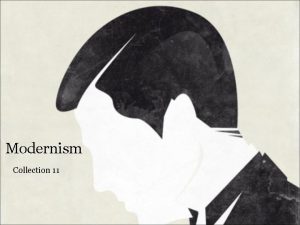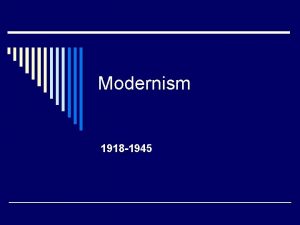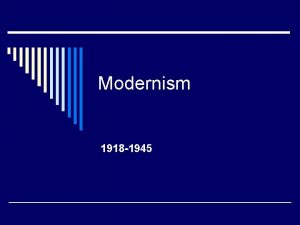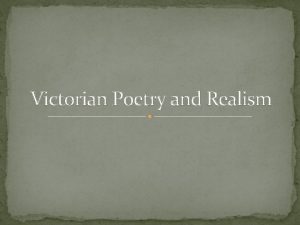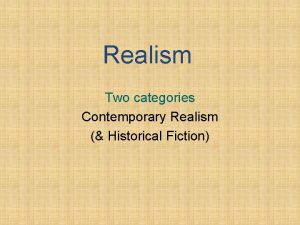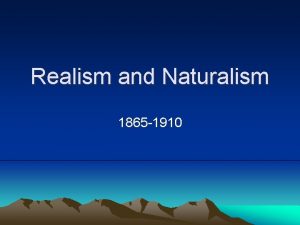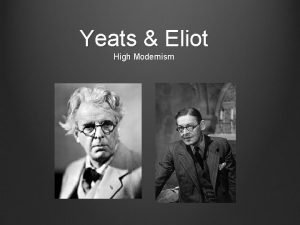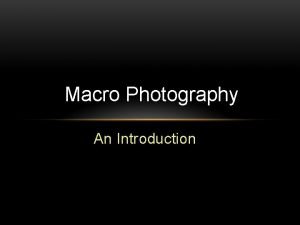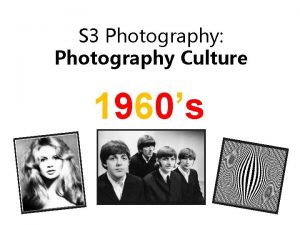CONTENT AREA 4 EARLY MODERNISM REALISM PHOTOGRAPHY 19














































- Slides: 46

CONTENT AREA 4 EARLY MODERNISM REALISM PHOTOGRAPHY 19 TH CENTURY ARCHITECTURE

REQUIRED CONTENT AREA WORKS Realism 113. Courbet, The Stone Breakers 115. Manet, Olympia 119. Rodin, The Burghers of Calais Photography 110. Daguerre, Still Life in Studio 114. Daumier, Nadar Raising Photography to the Height of Art 117. Muybridge, The Horse in Motion 127. Alfred Stieglitz, The Steerage Early Modern Architecture 124. Carson, Pirie, Scott and Company Building

CONTEXT: LATE EUROPE TH 19 CENTURY �Industrial Revolution � Urbanization, massive movements to cities and resulting in social unrest �Franco-Prussian War (1870) � France at war and in turmoil �Science=progress � New materials, new knowledge � Darwin and dramatic medical advancements �Invention of photography (1839) � By Daguerre/Talbot, by 1850 it is well-known � Maybridge exhibition in 1881 �Lithography (beginning in 1850 s) � Resulted in wider distribution of art and other printing techniques

INDUSTRIALIZATION OF EUROPE AND U. S. ABOUT 1850 4

TH 19 CONTEXT: LATE CENTURY EUROPE Great Exhibition of all Nations (England) 1851 Cast iron, a new building material for architects results in mass production of complicated decorative devices and prefabrication of building units off site Colonization by European powers continues/Admiral Perry opens Japan (1853) Forced trade with Europe, influx of Japanese prints/other objects Art for art’s sake Examination of the definition of art and the role of art Art that is done for the sake of doing, without historicism or histrionics, without symbolism and metaphor

REALISM: CONTEXT Realism is a rejection of Romanticism and the Salon Common day occurrences and subjects of humble origins doing mundane activities Shocked the public and the salon by rejecting traditional “history” paintings and mythological subjects Artist’s alliance with radical politics of the time Socialism and the working (under-class) laborers “Art for art’s sake” Direct and “honest” (objective) presentation of subject matter Invention of photography Painting begins to move away from being a “window into another world” and starts to become an object on the wall Cast iron International Exhibitions Exposure to new ideas and non-European cultures Franco-Prussian war

REALISM: CONCEPTS � Reaction to Romanticism (which was seen as an escape from everyday life) � Often an alliance with radical politics of the time � Subject matter of art drawn from real life � Genre scenes (the ordinary) elevated to the position of history painting � Simple, direct observation and recording of reality � Objective: a sense of detachment in regard to the representation of subject matter � An optical approach to the visible world and art making � Painting as object: paint surface often textural, paint applied in impasto � Seen by contemporary critics of the time as “crude” and “primitive”

THIRD CLASS CARRIAGE, 1862, REALISM, FRANCE** -Power of art to serve political ends, political and social NOT IN 250 agitation accompanied the violent and social agitation -Artists started to become suspects of subversive intentions, people began to be arrested for making bold statements -Daumier defended the working classes, confronted authority with social criticism -Produced lithographs, reached a large audience -View into the cramped railway cars of the 1860 s -Depicted in unposed attitudes and unplanned arrangements -Anonymous and insignificant, faces vague, blank, impersonal -Random collection of details from ordinary life

BURIAL AT ORNANS, 1850, REALISM, FRANCE, OIL ON CANVAS** -Small funeral set in bleak landscape -Clergyman reads, others are NOT IN 250 gathered around -Monumental scale of burial paintings, it is stark and unheroic -Three groups: somberly clad women, similarly clad men by the open grave, and assorted churchmen on the left. -Faces are portraits, Courbet’s sisters and friends -Dark sky and pit below in the foreground -Ordinary rhythms of daily existence -Realists call attention to painting by pictorial construction: intentionally simple and direct methods of composition and technique

STONE BREAKERS, 1850, REALISM, FRANCE, OIL -Glimpse into real life of rural menial 2 men, one old ON laborers, CANVAS and one young -Common rural town in the background -Lowest job in French society -Juxtaposing youth and age, remain poor their entire lives -Not romanticized or idealized -Isolated physically and economically -Colors and angles suggest dismal nature and mechanism -1848 laborers rebelled against bourgeois leaders, demanding better working conditions. Put down in days, but many died -Original was destroyed during WWII when a transport vehicle moving it in Dresden was

• On top, Millet’s The Gleaners, hardworking but unidealized peasants • Hard working but not depicted as harshly • Aerial perspective is calming, close up and low perspective is uncomfortable • Brush strokes are rough and choppy in Stone Breakers • Rejection of Neoclassicist style • No attention given to faces in either work

GLEANERS, 1857, REALISM, FRANCE, OIL ON CANVAS** -Subjects occupations NOT in. IN 250 of the everyday world -Millet was part of a group of painters who settled in the countryside to paint (Barbizon School) -Millet was also from a peasant family and identified with the country poor -Three peasant women finding the scraps of grain, allowed to do this by wealthy landowners -Monumental figures against a large sky -Sentimental, unlike Courbet -Disliked by public, especially rich middle and upper classes -Influenced socialist movements and

DEJENEUR SUR L’HERBE, 1860 S , REALISM, FRANCE, OIL ON -Important in the development of CANVAS**NOT Impressionism -Two. IN women and two men enjoying a 250 picnic -Consistent with Realist principles, all foreground figures are based on real people. Woman is his favorite muse at the time, his brother has a cane, and the other man is a famous sculptor -Unidealized nude, but comfortable in surroundings, gazing at the viewer -Outraged the public -Called attention to the act of making art, stark lighting, soft brushstrokes contrasted with hard lines of the figures -Moving away from illusionism and toward an open acknowledgement of painting’s properties

MANET, OLYMPIA 1860 S, REALISM, FRANCE, OIL ON CANVAS -Young, white prostitute (Olympia was a common name for prostitutes at this time) -At ease and gazes at the viewer -Horrified critics and the public: shamelessness of her gaze -Depiction of a black woman was not new, but with a white prostitute it evoked moral depravity, inferiority, and animalistic sexuality -Made references to racial divisions -Also departed from accepted art practices: rough brush

THE HORSE FAIR, 1850 S, REALISM, FRANCE, OIL ON CANVAS** -Most celebrated female artist of the 19 century. IN 250 NOT th -Received training from her father (socialist who championed the education and enfranchisement of women) -Realist passion for accuracy in paintings, but resisted the depictions of problematic social/political situations -Turned attention to French countryside and animals -Studied anatomy at the fairs and the slaughterhouses -Also inspired by the Parthenon frieze -Dramatic lighting, loose brushwork, rolling sky -Different movement but based on reality

GROSS CLINIC, 1875, REALISM, AMERICA, OIL ON -Increasing emphasis on science CANVAS**NOT -Connection between progress and science. INwas 250 Science mankind’s highest achievement -Eakins studied both painting and medical anatomy -American way of painting, combining admiration for the accurate with a hunger for the truth -Presents renowned surgeon in operating amphitheater -Lecturing about his surgery with bloody hands -Watching is the patient’s mother, an anesthetist holds cloth over his face -Eakins believed that knowledge was a prerequisite of art -Participated in scientific observation for his

SARGENT, DAUGHTERS OF EDWARD DARLEY BOLT, 1882, AMERICA, OIL ON CANVAS** NOT IN -Looser 250 Realist style, influenced by Velasquez’s “Las Meninas -Four girls in the drawing room, friend of their parents -Informal, eccentric arrangement -Captured naïve openness of child in foreground, self conscious adolescents -Shows that it was the Realist artist’s business to record modern people in modern contexts

TANNER, THE THANKFUL POOR, 1890, REALISM, AMERICA, OIL ON CANVAS** NOTlives INof 250 -Depict ordinary people -Studied with Eakin -Careful study from nature with a desire to portray with dignity the life of the ordinary people he had been raised among, as the son of an African-American minister -Grandfather and grandson are clear and their surroundings dissolve into color and light -Deep sense of sanctity in everyday experience, was important for Tanner

MILLAIS, OPHELIA, 1850, REALISM, ENGLAND** -Part of the IN Pre-Raphaelite NOT 250 Brotherhood, group of artists who chose to portray fictional, historical, and fanciful subjects. Wanted to create art free of “tired and artificial manner of the academies” -Careful in study of visual facts -From Shakespeare’s “Hamlet”, the drowning of Ophelia -Faithful to every detail, even though story is fictitious -Set by a river in Surrey and had a model lay in the bath for hours as he painted.

RODIN, BURGHERS OF CALAIS, 1900, REALISM, FRANCE, BRONZE -Fascinated by the human body in motion, profound knowledge of the anatomy -Nude and draped figures, life-size group -Commemorating a heroic episode during the Hundred Years War-in 1347 six leading citizens offered their lives to the King of England if he would stop attacking the city -Bedraggled looking men, wandering instead of clustered together -Roughly textured surfaces add to the pathos and interest of the viewers -Hoped it would inspire viewers, but the city didn’t like it and removed it to an isolated location

RODIN, WALKING MAN, 1905, CAST 1962. BRONZE, 6’ 11 3/4” HIGH. HIRSHHORN MUSEUM AND SCULPTURE GARDEN, SMITHSONIAN INSTITUTION, WASHINGTON (GIFT OF JOSEPH H. 21





PAXTON, CRYSTAL PALACE, 1850, REALISM, ENGLAND, GLASS AND METAL**NOT IN 250 “undraped” construction -Completely became popular in the conservatories of English country estates -Submitted the winning design to house the Great Exhibition of 1851 to house “works of industry of all nations” -Constructed with pre-fabricated parts, put together in 6 months -Flat roofed nave, barrel-vaulted transept -Provided ample interior space for display -Replica was later made, but burned down in 1936

EIFFEL, EIFFEL TOWER, 1889, REALISM, FRANCE** NOT IN 250 -Originally seen as a symbol of modern Paris -Was designed for the Great Exhibition in Paris in 1889 -984 ft tall -Tower rests of four supports, arches that hide its bulk -Blurs the distinction between interior and exterior, important to 20 th century art and architecture -Showed that modern materials and processes could create a whole new style and innovative approach to design

RICHARDSON, MARSHALL FIELD BUILDING, 1887, REALISM, AMERICA**NO -Desire for greater speed and T IN 250 economy in buildings, and reduction of fire hazards -Use of cast-iron architecture inside masonry to strengthen its fire resistance -Favored Romanesque architecture, round arches and heavy masonry walls -Occupied a city block -Tripartite elevation of Roman aqueduct or Renaissance palace -Horizontal windows, broken

EARLY MODERN ARCHITECTURE Innovations/Concepts Steel frame replaces cast-iron (more heat tolerant) Skyscraper-new verticality possible with the use of new materials Elimination of ornament and sculptural decoration Rigid symmetry with no strong central axis Internal skeletal construction of steel with masonry facades First skyscraper was built during this period Interaction between architecture and commerce

Carson, Pirie, Scott and Company Building. Chicago, Illinois, U. S. Louis Sullivan (architect). 1899– 1903 C. E. Iron, steel, glass, and terra cotta. (3 images)

• Sullivan wrote a treatise “The Tall Office Building Artistically Considered” • Analyzed the problem of high-rise commercial architecture • “Form must follow function” his most famous phrase • Design must reflect the social purpose of a particular space • Describes the ideal skyscraper • Ground floor-easy public access, light, open • Second floor-also open and accessible by stairways • Floors after should follow the same as the second floor, with offices, looking the same because they have the same function • Should be topped with an attic story and distinct cornice line to mark the end point and to set it apart from other buildings in the cityscape • Purpose of a skyscraper was to be tall, so

• Was adapted for a department store purchased by Carson, Pirie, and Scott • Highlighted the lower street-level section and entryway to draw shoppers into the store • Windows on the ground floor, displaying store’s products, are larger than those above • Three entrance doors are placed in rounded bay on the corner of the site so they are visible from all directions approaching the building

• Corner entryway and the entire base section are differentiated from the bare upper stories by a unified system of extreme decoration • Cast-iron ornament contains highly complicated, delicate, organic, and floral motifs that had become the hallmark of Sullivan’s aesthetic design • Decorative program served overall function: to distinguish itself from the buildings around it and to make the store attractive to potential

• Upper floors show an adaptation of the skyscraper theory • Each floor contains successive, identical windows on a white terra-cotta façade • Overhanging cornice at the top ends the building’s ascent • Makes the attic level distinct from the broad mid-section and the cast-iron decoration of the base level • Primary thrust is horizontal rather than vertical, emphasizes the long uninterrupted lines that run around the building toward the entrance and flow seamlessly around the corner • The window shapes were a requirement of the department building so that shoppers could see the merchandise, not offices

EARLY PHOTOGRAPHY Struggle to define photography Art or science? Chemistry needed to register an image was created during the 19 th century Camera obscura was used before Light was passed through a small hole that reflected an image in reverse Joseph Nicephore Niepce invented a light-sensitive surface Development of photography was largely related to technological improvements Speed-the length of the exposure period Resolution- longer the exposure, the more grainy the image Permanence-how to stop any further chemical reaction, once the desired exposure had been achieved Was solved by the invention of hypo in 1839 that reversed the light sensitivity of paper

Daguerre invented a new process in 1839 called “daguerreotype” which significantly reduced exposure time and created a lasting result, but only a single image could be produced Was a one-of-a-kind image on a highly-polished, silverplated sheet of copper His methods were championed at the Academy of Sciences in Paris Process was explained step-bystep in front of a joint session of the Academy of Sciences and Academy of Arts Still Life in Studio. Louis. Jacques-Mandé Daguerre. 1837 C. E. Photograph.

Promoted his invention as both science and art Still-life compositions of plaster casts of antique sculptures, ideal because white reflects light well and were immobile for long periods of time His invention caused millions of people to want their portraits recorded for posterity Still Life in Studio. Louis-Jacques-Mandé Daguerre. 1837 C. E. Photograph.

AFTER DAGUERRE Others tinkered with the chemistry to make it practical for portraiture, reducing exposure time to minutes Devices were created to help sitters remain motionless Portraiture accounted for the vast majority of daguerrotypes Portrait studios were set up where middle class could feel like upper class Did not care about looking artistic, rather that they were recorded accurately Some men (mostly with money and time) took more intimate photos of family and friends on their own Artists and scientists also used daguerrotypes Some artists resisted the change Others embraced it as a means of new expression Could exactly record what was seen Modern audiences were also fascinated with the images that were brought back from other lands People wanted to travel as a result Paper photography began to supersede the daguerreotype in the 1850 s Lacked clarity but could make multiple prints

Collodion method was invented in 1851 Process involved fixing a substance, gun cotton, onto a glass plate, allowing for a shorter exposure time (3 -5 minutes) as well as clearer image Disadvantage was that it needed to be exposed and developed while the chemical coating was still wet Meant that photographers had to carry portable darkrooms to develop images immediately after exposure Difficulty in method and uncertainty of growing status was publically criticized in works like this one Nadar Raising Photography to the Height of Art. Honoré Daumier. 1862 C. E. Lithograph.


Nadar was one of the most prominent photographers in Paris at the time Pseudonym of Gaspard-Felix Tournachon Studied as a caricaturist Was known for making caricatures of prominent figures in Paris Was known for capturing the first aerial photographs from the basket of a hot air balloon

Daumier began satirical works in 1830 Made portrait busts criticizing certain types of contemporary men Was hired by the paper La Caricature Was later seized by Louis Philippe Daumier was sent to prison Made around 4, 000 images Transfer lithography Drawing is made on paper rather than stone Drawing is transferred to stone Ink is applied to greasetreated surface on flat surface Non-image, blank areas, repel ink Then printed onto paper 114. Nadar Raising Photography to the Height of Art. Honoré Daumier. 1862 C. E. Lithograph.

Further advances were made to make photography less labor intensive 1867 -dry glass plate was invented Reduced the inconvenience of the wet collodion method Prepared glass plates could be purchased eliminating the need to mess with chemicals Exposure time was now 1/25 of a second Allowed moving objects to be photographed and lessening the need for a tripod Development is celebrated in Eadweard Muybridge’s The Horse in Motion Was done to settle the question of whether or not a horse has all four feet off the ground when galloping EADWEARD MUYBRIDGE, THE HORSE IN MOTION. COURBET, 1878, PHOTOGRAPH

Muybridge considered himself an artist but was encouraged by scientific investigation Example of collotype Invented by William Henry Fox Talbot Patented in 1841 Creation of the paper negative that transformed a negative image into a positive image, allowing for more than one copy of the picture

• Was taken from the first class deck by Stieglitz on a transatlantic journey from New York to Paris on May 14, 1907 • • Was married a status-conscious woman Was uncomfortable with the upper class passengers and felt out of place • Walked to the front of the ship to escape the nouveau riches and looked down to see the women and children of the lower classes • Wanted to be with them, rather than above him • When describing this in an essay he also says that it encapsulated his mission to elevate photography to the status of fine art, by engaging in the same dialogues about abstraction that European artists were engaged with Alfred Stieglitz, The Steerage, 1907, photogravure

• Photography is not only documentary but can also convey abstraction • Not only about significant forms of shapes forms and textures, but also a message about its subject • • The immigrants who were rejected at Ellis Island returning to their country Or returning to see relatives and encourage them to come back to the USA with them • Stieglitz was familiar with the debates about immigration reform and the terrible conditions passengers in steerage were subjected to • • His father had immigrated from Germany between 1845 and 1855; exemplified the American dream However, he did not approve of admitting the uneducated and marginal to the US Alfred Stieglitz, The Steerage, 1907, photogravure
 Realism naturalism modernism
Realism naturalism modernism Modernism and realism
Modernism and realism Realism vs modernism
Realism vs modernism Realism vs anti realism
Realism vs anti realism Briefly summarise
Briefly summarise Realism vs anti realism
Realism vs anti realism Is abstract photography same as conceptual photography
Is abstract photography same as conceptual photography Early years photography
Early years photography Carrier content vs real content
Carrier content vs real content Static content vs dynamic content
Static content vs dynamic content Early cpr and early defibrillation can: *
Early cpr and early defibrillation can: * Vaap asol
Vaap asol Vaap content area cover sheet
Vaap content area cover sheet Modernist vs traditionalist
Modernist vs traditionalist Modernism and experimentation in american literature
Modernism and experimentation in american literature Suzi gablik
Suzi gablik The great gatsby romanticism
The great gatsby romanticism Difference between modernism and postmodernism
Difference between modernism and postmodernism What is premodernism
What is premodernism Postmodernism media examples
Postmodernism media examples Post modernism sociology
Post modernism sociology Modernism vs postmodernism
Modernism vs postmodernism Modernist vs postmodernist
Modernist vs postmodernist Modernism era
Modernism era What is pictorial modernism
What is pictorial modernism Timeline of modernism
Timeline of modernism Metamorphosis quiz
Metamorphosis quiz Modernism in literature
Modernism in literature Modernism in literature
Modernism in literature Modernist literature
Modernist literature Post modernism literature
Post modernism literature Modernism and the american dream
Modernism and the american dream Postmodernism vs modernism literature
Postmodernism vs modernism literature Hills like white elephants author's purpose
Hills like white elephants author's purpose Postmodernism language games
Postmodernism language games Modernism vs postmodernism
Modernism vs postmodernism Emily dickinson modernism
Emily dickinson modernism Robert wohl
Robert wohl Post modernism music
Post modernism music Naturalism authors
Naturalism authors Wiiralt kabaree
Wiiralt kabaree Hemingway modernist
Hemingway modernist Experimentation in modernism
Experimentation in modernism Causes of modernism
Causes of modernism Modernism definition
Modernism definition Chapter 29 the clash between traditionalism and modernism
Chapter 29 the clash between traditionalism and modernism Who wrote this poem
Who wrote this poem
